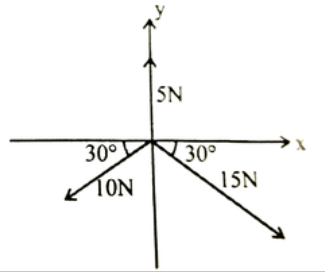Two forces each of magnitude 2N, act at an angle of 60∘. The magnitude of the resultant force
√1.1 Newton
√4 Newton
√12 Newton
√14.9 Newton
The correct Answer is:C
To find the magnitude of the resultant force when two forces of equal magnitude act at an angle, we can use the formula for the resultant of two vectors. Here's the step-by-step solution:
Step 1: Identify the given values
- Magnitude of the first force, F1=2N
- Magnitude of the second force, F2=2N
- Angle between the two forces, θ=60∘
Step 2: Write the formula for the resultant force
The magnitude of the resultant force Fnet can be calculated using the formula:
Fnet=√F21+F22+2F1F2cos(θ)
Step 3: Substitute the values into the formula
Substituting the values we have:
Fnet=√(2)2+(2)2+2⋅2⋅2⋅cos(60∘)
Step 4: Calculate each term
1. Calculate F21 and F22:
F21=22=4
F22=22=4
2. Calculate 2F1F2:
2⋅2⋅2=8
3. Calculate cos(60∘):
cos(60∘)=12
4. Substitute cos(60∘) back into the equation:
8⋅cos(60∘)=8⋅12=4
Step 5: Combine all terms
Now substitute back into the resultant force equation:
Fnet=√4+4+4=√12
Step 6: Calculate the final result
Fnet=√12=2√3N
Final Answer
The magnitude of the resultant force is 2√3N.
---
- Magnitude of the first force, F1=2N
- Magnitude of the second force, F2=2N
- Angle between the two forces, θ=60∘
The magnitude of the resultant force Fnet can be calculated using the formula:
Fnet=√F21+F22+2F1F2cos(θ)
Substituting the values we have:
Fnet=√(2)2+(2)2+2⋅2⋅2⋅cos(60∘)
1. Calculate F21 and F22:
F21=22=4
F22=22=4
2⋅2⋅2=8
cos(60∘)=12
8⋅cos(60∘)=8⋅12=4
Now substitute back into the resultant force equation:
Fnet=√4+4+4=√12
Fnet=√12=2√3N
The magnitude of the resultant force is 2√3N.
Topper's Solved these Questions
- COMPETITION CARE UNITBOOK - ICSECHAPTER - COMPETITION CARE UNITEXERCISE - NDA EXAM QUESTIONS
55 Videos
- CIRCULAR MOTION BOOK - ICSECHAPTER - CIRCULAR MOTION EXERCISE - MODULE 2 (FROM ROTATIONAL KINETIC ENERGY , WORK ,POWER)
24 Videos
- DIMENSIONSBOOK - ICSECHAPTER - DIMENSIONSEXERCISE - SELECTED PROBLEMS (FROM CONVERSIONS OF ONE SYSTEMS OF UNITS INTO ANOTHER)
9 Videos
Similar Questions
Two forces of magnitudes P and Q are inclined at an angle (θ). The magnitude of their resultant is 3Q. When the inclination is changed to (180∘−θ), the magnitude of the resultant force becomes Q. Find the ratio of the forces.
View SolutionTwo forces with equal magnitudes F act on a body and the magnitude of the resultant force is F /3. The angle between the two forces is
View Solution
Knowledge Check
A body of mass 2kg is acted by two forces each of magnitude 1 newton, making an angle of 60∘ with each other. The net acceleration of the body (inm/s2) is
A0.5B1C√3/2D√2/3
Find the magnitude of the resultant of shown forces :-

View SolutionTwo equal forces are acting at a point with an angle of 60∘ between them. If the resultant force is equal to 40√3N, The magnitude of each force is :-
View SolutionTwo equal forces (P each) act at a point inclined to each other at an angle of 120∘. The magnitude of their resultant is
View SolutionThe resultant of two forces has magnitude 20N. One of the forces is of magnitude 20√3N and makes an angle of 30∘ with the resultant. Then what is the magnitude of the other force?
View SolutionTwo forces of mangitude F1 and F2 are acting on an object.The magnitude of the net force Fnet on the object will be in the range.
View SolutionTwo equal forces are acting at a point with an angle 60∘ between them. If the resultant force is equal to 4√3N, the magnitude of each force is
View SolutionTwo forces of magnitude 3N and 4N respectively are acting on a body. Calculate the resultant force if the angle between them is
0∘
View Solution
